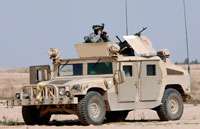Study explores injury risk in military Humvee crashes

A new report by researchers from the Johns Hopkins Center for Injury Research and Policy examines the risk factors for injuries to U.S. military personnel from crashes involving highly mobile multipurpose wheeled vehicles (HMMWVs), more commonly known as Humvees. According to the study, involvement in combat and serving as the vehicle's operator or gunner posed the greatest risk for injury. It is the first published analysis of factors associated with Humvee injury risk in a deployed setting, and is in the August issue of the journal Military Medicine.
According to the U.S. Department of Army, motor vehicle crashes—both privately owned and military vehicles—account for nearly one-third of all U.S. military fatalities annually and are among the top five causes of hospitalization for personnel.
"Nearly half of all those involved in motor vehicle crashes in Iraq, Kuwait, and Afghanistan from 2002-2006 were in Humvees at the time of the crash," said principal investigator Keshia Pollack, PhD, an associate professor with the Johns Hopkins Center for Injury Research and Policy and the Johns Hopkins Bloomberg School of Public Health. "It's critical that we consider risk factors for these crashes, and use this knowledge to develop injury prevention programs and policies," she said. For example, given the association between being in a combat setting (versus crashes that do not occur during combat situations and injury), training for the military in combat-like situations through simulation or live-training exercises for all drivers could be important. Similarly, as gunners are often in an exposed position on top of the vehicle, equipment or devices that protect them from injury in rollover crashes should be explored.
The authors, who included researchers from the U.S. Army as well as the Johns Hopkins Center for Injury Research and Policy, used data on U.S. Army vehicle crashes from 1999 to 2006 collected by the Army Safety Management Information System. The total documented cases of crashes was narrowed to focus on the sub-population of active duty U.S. Army, Army Reserve, and National Guard soldiers involved in military vehicle crashes in the countries of Iraq, Kuwait, and Afghanistan, occurring during Operation Iraqi Freedom and Operation Enduring Freedom.
"The finding that the odds of being injured when the crash occurred in combat indicates that in a high-stress situation, the soldier may be distracted or less likely to take self-protective measures or follow safety regulations," said study co-author Susan P. Baker, MPH, a professor with the Johns Hopkins Center for Injury Research and Policy. "As motor vehicle crashes are responsible for one-third of all U.S. military deaths annually, it's imperative that significant measures be taken to save lives."














